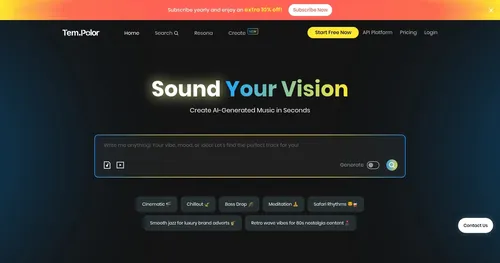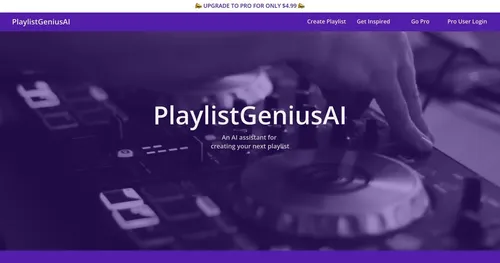Sonoteller

Sonoteller is a tool that feels like it’s been plucked from a music nerd’s wildest dreams. You pop in a song — say, a YouTube URL or your own audio file — and in roughly a minute, it spits out a breakdown that’s part musicologist, part data wizard. It’s not just about identifying the genre or BPM, though it does that with precision. It’s about understanding the soul of a song: the mood, the instruments, the lyrical themes, even that elusive “golden minute” where the chorus or a key moment shines. For anyone who’s ever wanted to dissect their favorite track or organize a sprawling music catalog, this tool is a game-changer.
What’s impressive is how Sonoteller listens to music almost like a human would, but with the rigor of a machine. It identifies genres (think indie rock or trap) and subgenres, flags explicit content, and pinpoints instruments — guitars, synths, you name it. It even catches the emotional undercurrents in lyrics, summarizing themes like heartbreak or rebellion. I tested it with a classic like Nirvana’s “Where Did You Sleep Last Night,” and it nailed the raw, haunting vibe, tagging the acoustic guitar and Kurt Cobain’s anguished delivery. For music supervisors or labels, the API integration is a big win, syncing seamlessly with catalog management systems to tag songs at scale, making them more discoverable on platforms like Spotify or Apple Music.
But it’s not flawless. Since it’s in beta, you might hit occasional hiccups — maybe a delay or a quirky genre tag that feels off, like calling a punk track “alternative pop.” The reliance on YouTube URLs for demos can also be a pain if you’re working with unpublished tracks, though the API handles private files well. Compared to competitors like Cyanite.ai or DISCO, Sonoteller stands out for its lyrical analysis depth, but Cyanite.ai might edge it out in mood-based tagging accuracy. DISCO, meanwhile, is more collaborative, better for team workflows. Still, SONOTELLER’s ability to blend lyric and music analysis in one package is rare.
The pricing seems reasonable for what you get, though it’s tied to API usage through RapidAPI, so costs depend on how much you analyze. Free tiers exist but come with limits, like 10 uses per month, which can feel restrictive for heavy users. Industry pros might love the discounted API plans, which streamline metadata delivery for streaming platforms. Casual users, though, might wish for a more generous free option.
One surprise? The “golden minute” feature. It’s not just a gimmick — it highlights the song’s emotional peak, which is gold for playlist curators or filmmakers hunting for the perfect track snippet. I think the tool’s biggest strength is its accessibility. You don’t need to be a tech genius to use it, just a music lover with a browser. My advice: start with the web version to test a few tracks, then explore the API if you’re managing a catalog.. and take it from there.
What are the key features? ⭐
- Song Summaries: Provides detailed breakdowns of lyrics and musical attributes.
- Golden Minute Identification: Highlights the emotional peak or key section of a song.
- Autotagging: Automatically tags music with genres, moods, and instruments for catalog management.
- API Integration: Enables large-scale analisys and syncing with music workflows.
- Explicit Content Flagging: Detects explicit lyrics for content filtering.
Who is it for? 🤔
Examples of what you can use it for 💭
- Music Enthusiast: Analyzes favorite songs to uncover lyrical themes and musical attributes.
- Music Supervisor: Tags tracks for sync licensing with detailed metadata for DSPs.
- Record Label: Uses API to autotag large catalogs for better streaming platform discoverability.
- Content Creator: Identifies song moods and key sections for curated playlists or videos.
- Music Educator: Studies song structures and lyrical content for teaching purposes.
Pros & Cons ⚖️
- Deep lyrical and music analysis
- Fast processing, about 1 minute
- API for scalable catalog management
- Limited free tier, 10 uses
- YouTube dependency for demos
FAQs 💬
Related tools ↙️
-
 Splash
An AI tool that can sing, rap, play instruments, compose and produce original music
Splash
An AI tool that can sing, rap, play instruments, compose and produce original music
-
MusicGPT Generates original music from text prompts in seconds
-
Songburst Generates original songs from text descriptions
-
 Tempolor
An AI-powered music generator that will turn your ideas into royalty-free songs
Tempolor
An AI-powered music generator that will turn your ideas into royalty-free songs
-
 PlaylistGeniusAI
Create expertly curated playlists with a single prompt in seconds
PlaylistGeniusAI
Create expertly curated playlists with a single prompt in seconds
-
Youka Transforms songs into karaoke videos with scrolling lyrics in minutes

